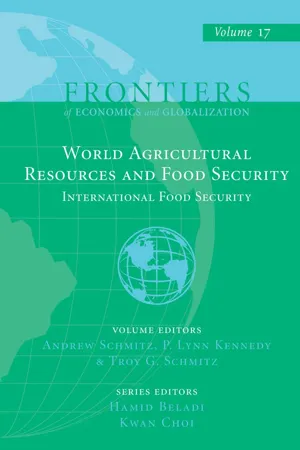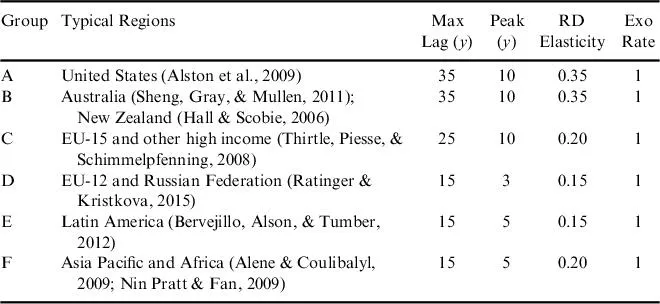Abstract
The purpose of this chapter is to analyze the impact of public agricultural Research and Development (R&D) investments on agricultural productivity and long-term food security to derive policy recommendations. The methodological approach is based on the application of the state-of-the art Computable General Equilibrium (CGE) model to R&D. By endogenizing R&D in global CGE models, it is possible to assess the impact of different public R&D policies on the food availability and food access of food security. This study found that R&D investments bring positive effects on the food access dimension of food security, particularly in places such as Sub-Saharan Africa where prices are expected to grow significantly by 2050, as agricultural land becomes scarcer and more expensive. Doubling the R&D intensity would soften the land constraints and substantially decelerate food prices, thus preventing the deterioration of living standards of rural households and leading to a gain in daily caloric consumption. The impact of alternative agricultural R&D policies on the various dimensions of food security has not been analyzed using a CGE framework, which enables capturing both the benefits and costs from R&D investments. Modeling the dynamic accumulation of R&D stocks makes it possible to analyze the effects of R&D on food security over time.
1. Introduction
There are various challenges for reaching long-term sustainable agricultural production and food security. On the one hand, there are increased demand pressures resulting from ongoing population growth, improvements in living standards in developing countries, and increased demand from nonfood sources (e.g., renewable energy sources). On the other hand, there are constraints on the production side due to climate change, limited agricultural land, and reduced agricultural labor. The Food and Agricultural Organization of the United Nations (FAO, 1996) estimates that food production will need to be increased by 60% to feed a global population of approximately 9 billion people in 2050. Around 80% of the projected growth will have to come from intensification, predominantly an increase in agricultural yields through better use of inputs (Alexandratos & Bruinsma, 2012).
Agricultural research and development (R&D) investments represent a possible solution for the food-security challenge, especially in developing countries where cereal yields are still well below the global average level. Continuous investments in R&D are important from the perspective of all four food-security dimensions, namely food availability, accessibility, utilization, and stability (FAO, 1996). The availability dimension of food security is associated with the physical supply of food. According to various scholars (Alston, Andersen, James, & Pardey, 2009; Avila & Evenson, 2010; Fuglie, 2012; Pardey & Beddow, 2013), investments in R&D are important drivers of agricultural productivity and food availability. R&D investments in better seeds and varieties during the Green Revolution resulted in lower agricultural prices, which contributed positively to the accessibility dimension of food security. By increasing agricultural productivity, the corresponding farmer income gains can translate into better nutrition, gains in dietary diversity, and improved health that affect positively the utilization and stability dimensions of food security.
Despite the key role of R&D investments when improving the dimensions of food security, only a few global model studies have explicitly assessed the impact of R&D investment on food security (Baldos, Hertel, & Fuglie, 2015; Dietrich, Schmitz, Lotze-Campen, Popp, & Miller, 2014; Hoddinot, Rosegrant, & Torero, 2012). These studies used partial equilibrium (PE) models such as International Model for Policy Analysis of Agricultural Commodities and Trade (IMPACT) and Model of Agricultural Production and its Impact on the Environment (MAgPIE) that can simulate the agricultural sector but cannot address the impact of agricultural R&D investment on the wider, global economy (for instance through lower prices of agricultural commodities). Therefore, we use a computable general equilibrium (CGE) model to analyze food security.
The objective of this chapter is to provide projections of agricultural production, food prices, and other food-security indicators toward 2050 with alternative scenarios of R&D investments. In the baseline scenario, R&D investments follow a constant share in agricultural gross domestic product (GDP). In the policy simulations, the impact of doubling and tripling shares of R&D investments in agricultural GDP on food security in targeted developing countries is analyzed, with the major focus on the regions of Sub-Saharan Africa, South Asia, and Latin America. The results are contrasted with a scenario in which land productivity follows an exogenous trend, thus with no R&D investments.
2. Methodology
2.1. The MAGNET model
In this case, we use an extended variant of the Global Trade Analysis Project (GTAP) model (Hertel & Hertel, 1997) known as the Modular Applied GeNeral Equilibrium Tool (MAGNET) (Woltjer et al., 2014). MAGNET is a neoclassical recursive dynamic multisector, multiregion CGE model that has been widely used to simulate the impacts of agricultural, trade, land use, and biofuel policies on global economic development (Banse, Van Meijl, Tabeau, & Woltjer, 2008; Francois, Van Meijl, & Van Tongeren, 2005; Nelson et al., 2014a, 2014b; Nowicki et al., 2009; Van Meijl, Van Rheenen, Tabeau, & Eickhout, 2006). MAGNET includes an improved treatment of agricultural sectors (such as the endogenous land supply curve), agricultural policy, and biofuel policy. On the consumption side, a dynamic CDE expenditure function is implemented that allows for changes in income elasticities when purchasing power parity (PPP)-corrected real GDP per capita changes. Segmentation and imperfect mobility between agricultural and nonagricultural labor and capital are introduced in the modeling of factor markets.
For the analysis in this chapter, MAGNET uses GTAP database version 8, final release (Narayanan, Aguiar, & McDougall, 2013) which contains data on the input-output structure for 140 countries for base year 2007. To conduct the analysis, we aggregate the data to 25 production sectors, from which 11 are primary agricultural sectors and 21 are regions (Appendix).
2.2. Incorporation of R&D-driven technical change
We focus on public agricultural R&D targeted to major improvements of seeds and varieties in the style of the Green Revolution. In other words, we assume that public agricultural R&D is responsible for biological technical change in line with the reasoning of Piesse, Shimpeffeling, and Thirtle (2011). Although one might argue that public R&D comprises a larger category than just land-oriented research, investment in improving crop varieties is still the key focus of publically funded research. We propose a global empirically based approach to link R&D with productivity coefficients applying the function of constant elasticity of substitution (CES) production structures in a global modeling framework. Besides being empirically based, the advantage of linking public R&D to productivity coefficients is that the agricultural sector benefits “freely” from the public R&D sector, while the government pays for all expenditures (increased governmental consumption is reflected in reduced savings to the rest of the economy). Thus, the public goods component of agricultural R&D is well captured. The alternative and more common approach in the CGE literature is to include knowledge as a new production factor resulting from cumulative R&D efforts. In this way, knowledge is embedded in producers’ cost minimization, meaning that agricultural producers have to pay for investing in R&D which is more appropriate for modeling private R&D effects.
In line with our assumptions, a separate R&D sector was disaggregated from the public services sector in the social accounting matrix (SAM), the basic data structure of CGE models that reflects all market transactions in an economy. A simple procedure of applying the share of public R&D expenditures in the value of the output of public services was applied to all cost components. This means that the public R&D sector employs the same share of skilled and unskilled labor as other public services. Various data sources were compiled to derive the value of public R&D expenditures for all 140 regions (Smeets Kristkova, Van Dijk, & Van Meijl, 2016). All values were converted to 2007 US dollars to homogenize with values of other variables in SAM.
Following the empirical evidence on the specific shape of knowledge stocks distribution over time, a gamma distribution function was incorporated in MAGNET for building R&D stocks from public R&D expenditures. In line with the evidence in the literature, regions were grouped into six vintage groups. R&D investments in high-income regions such as the United States exhibit the longest lags corresponding to the nature of the research (basic research prevails). On the other hand, developing regions are allocated to vintage groups with shorter lags due to the more adaptive nature of research (Table 1). Similarly, the elasticity values vary with the vintage groups and generally follow the pattern that the longer the R&D distribution lag is, the higher the return and the elasticity of technical change with respect to R&D (the lags and obtained elasticities from neutral and factor-biased studies are comparable).
Table 1. Parameters of the gamma distribution function of R&D stock accumulation per vintage group
The growth of the cumulated R&D stocks from the gamma distribution is linked to the land-augmenting technical change as shown in the following eq...

